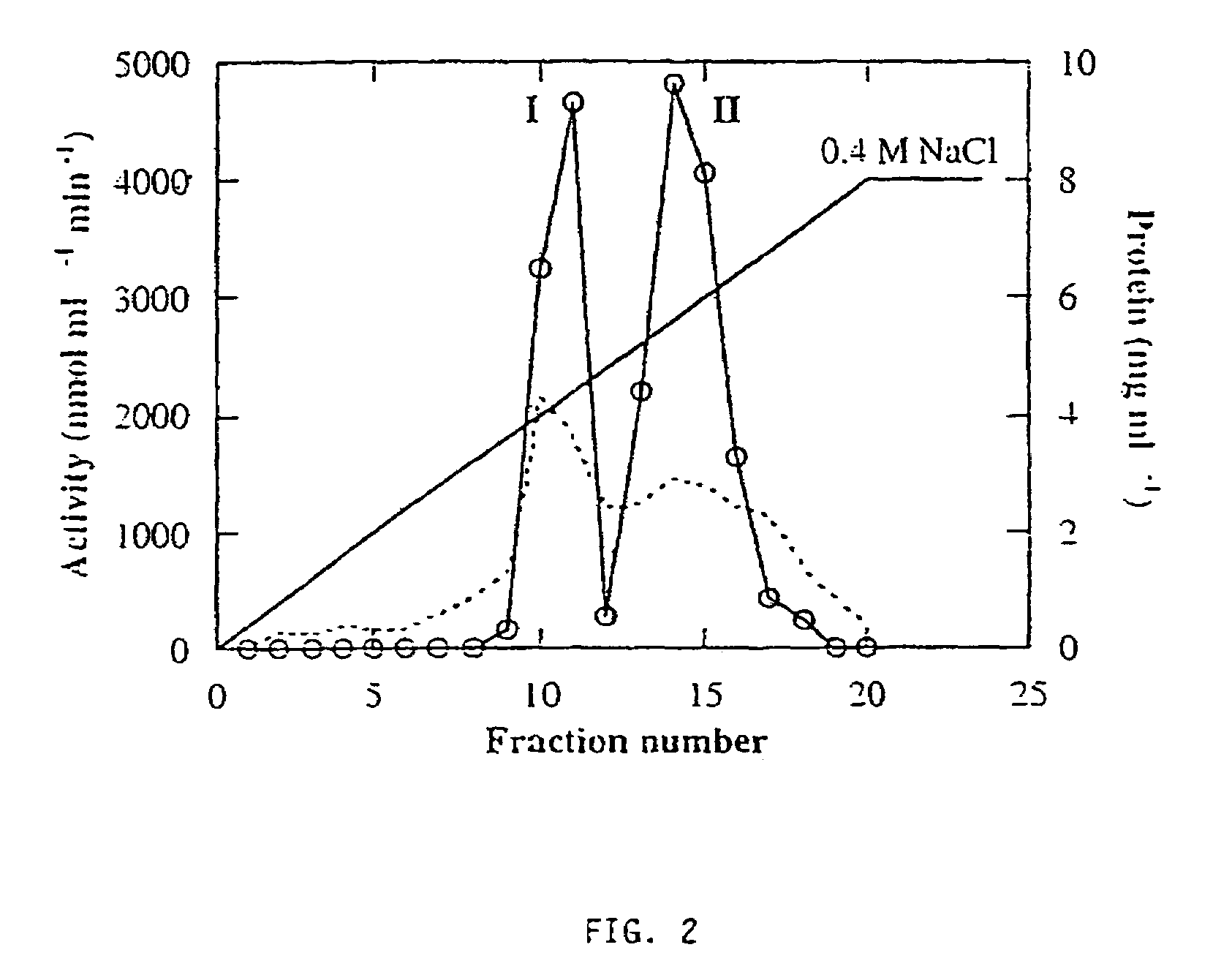Plant-derived alkaline alpha-galactosidase
a technology of alpha-galactosidase and plant-derived enzymes, which is applied in the field of alkaline alpha-galactosidase, can solve the problems of soybean protein precipitation, inability to clearly distinguish such activity, and use of acidic alpha-galactosidase in biotechnological and industrial applications, etc., and achieve the effect of reducing the capability of a food produ
- Summary
- Abstract
- Description
- Claims
- Application Information
AI Technical Summary
Benefits of technology
Problems solved by technology
Method used
Image
Examples
example 1
Purification of Alpha-Galactosidases from Melon Fruit
[0126]Three forms of alpha-galactosidase were resolved from young melon fruit mesocarp by DEAE-Sepharose ion exchange chromatography, in conjunction with Mono-Q chromatography, using pNPG as substrate (FIGS. 1 and 2). The first peak showed higher activity at pH 5.5 than at pH 7.5, while the latter two peaks both showed activity at pH 7.5 with little activity at pH 5.5. Accordingly, we referred the first peak as an acid form of alpha-galactosidase and the other two peaks as alkaline alpha-galactosidases Form I and Form II, respectively. The three enzyme forms were partially purified for the purpose of characterization (Table 1). Mono-Q ion exchange successfully resolved the two alkaline forms, and hydrophobic interaction chromatography was useful in the purification of alkaline Form II. After further purification, as described in Table 1, the two alkaline forms were electrophoresed on a denaturing SDS-PAGE gel and a photograph of t...
example 2
Changes of Acid and Alkaline Alpha-Galactosidases During Melon Fruit Development
[0141]The substrate preferences (Table 2) and pH profiles (FIG. 6A) from the purified acid and Form I and Form II alkaline alpha-galactosidases allowed us to measure and estimate their activities even in crude extracts of melon fruit, using their natural substrates. Very little overlap in activity occurs between pH 5.5 and pH 7.5 (FIG. 4A) and, at pH 7.5, the activities of alkaline alpha-galactosidase I and II in the crude extracts could be distinguished by their respective activities when using raffinose or stachyose as substrate. The activity with raffinose at pH 7.5 is a good indicator of Form I activity since Form II is relatively specific for stachyose. There should be an overestimation of Form II activity when using stachyose due the hydrolysis of this substrate by Form I which is also present in the crude extract. Nevertheless, distinct developmental patterns of alpha-galactosidase activities are ...
example 3
Alkaline Alpha-Galactosidases from Germinating Barley Seeds
[0149]Storage carbohydrates are of great importance in seeds of mono- and dicot plants, and raffinose is found in great quantities at this stage in seed-bearing plant development. In order to further determine the relevance of the alkaline alpha galactosidase of the present invention in plant developmental processes, the enzyme was detected and purified from germinating barley seeds.
[0150]When extracted and separated as described hereinabove for the melon plant, germinating barley seeds demonstrated a high activity of alkaline alpha-galactosidase measured at alkaline pH (pH 8 / pH 5 activity ratio equals 10.48), indicating a highly specific alkaline alpha-galactosidase fraction.
[0151]Comparison of substrate specificity of the HPLC (MonoQ)-purified barley seed enzyme preparations demonstrated that the enzyme has a broad specificity at alkaline pH, with nearly equal catalytic activity measured with raffinose and stachyose substr...
PUM
 Login to View More
Login to View More Abstract
Description
Claims
Application Information
 Login to View More
Login to View More - R&D
- Intellectual Property
- Life Sciences
- Materials
- Tech Scout
- Unparalleled Data Quality
- Higher Quality Content
- 60% Fewer Hallucinations
Browse by: Latest US Patents, China's latest patents, Technical Efficacy Thesaurus, Application Domain, Technology Topic, Popular Technical Reports.
© 2025 PatSnap. All rights reserved.Legal|Privacy policy|Modern Slavery Act Transparency Statement|Sitemap|About US| Contact US: help@patsnap.com



